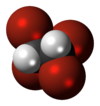Tetrabromoethane
 |
|||
 |
|||
|
|
|||
| Names | |||
|---|---|---|---|
|
IUPAC name
1,1,2,2-Tetrabromoethane
|
|||
Other names
|
|||
| Identifiers | |||
|
3D model (JSmol)
|
|||
| Abbreviations | TBE | ||
| 1098321 | |||
| ChemSpider | |||
| ECHA InfoCard | 100.001.083 | ||
| EC Number | 201-191-5 | ||
| MeSH | 1,1,2,2-tetrabromoethane | ||
|
PubChem CID
|
|||
| RTECS number | KI8225000 | ||
| UN number | 2504 | ||
|
|||
|
|||
| Properties | |||
| C2H2Br4 | |||
| Molar mass | 345.65 g·mol−1 | ||
| Appearance | Colourless liquid | ||
| Density | 2.967 g mL−1 | ||
| Melting point | −1.0 °C; 30.3 °F; 272.2 K | ||
| Boiling point | 243.6 °C; 470.4 °F; 516.7 K | ||
| 630 mg L−1 (at 20 °C) | |||
| Vapor pressure | 10 Pa (at 20 °C) | ||
| -123.4·10−6 cm3/mol | |||
|
Refractive index (nD)
|
1.637 | ||
| Thermochemistry | |||
| 165.7 J K−1 mol−1 | |||
| Hazards | |||
| Safety data sheet | hells-confetti.com | ||
| GHS pictograms |  |
||
| GHS signal word | DANGER | ||
| H319, H330, H412 | |||
| P260, P273, P284, P305+351+338, P310 | |||
| NFPA 704 | |||
| Flash point | 97 °C (207 °F; 370 K) | ||
| 335 °C (635 °F; 608 K) | |||
| Lethal dose or concentration (LD, LC): | |||
|
LD50 (median dose)
|
|
||
|
LC50 (median concentration)
|
38 ppm (rat, 4 hr) | ||
| US health exposure limits (NIOSH): | |||
|
PEL (Permissible)
|
TWA 1 ppm (14 mg/m3) | ||
|
REL (Recommended)
|
None established | ||
|
IDLH (Immediate danger)
|
8 ppm | ||
| Related compounds | |||
|
Related alkanes
|
|||
|
Except where otherwise noted, data are given for materials in their standard state (at 25 °C [77 °F], 100 kPa).
|
|||
|
|
|||
| Infobox references | |||
Tetrabromoethane (TBE) is a halogenated hydrocarbon, chemical formula C2H2Br4. Although three bromine atoms may bind to one of the carbon atoms creating 1,1,1,2-tetrabromoethane this is not thermodynamically favorable, so in practice tetrabromoethane is equal to 1,1,2,2-tetrabromoethane, where each carbon atom binds two bromine atoms.
It has an unusually high density for an organic compound, near 3 g/mL, due largely to the four bromine atoms. TBE is a liquid at room temperature, and is used to separate mineral ores from its supporting rock by means of preferential flotation. Sand, limestone, dolomite, and other types of rock material will float on TBE, while minerals such as sphalerite, galena and pyrite will sink. A related compound, bromoform, is also sometimes used in these applications, however, TBE is more practical because of its wider liquid range and lower vapor pressure. Acute TBE poisoning has been known to occur.
...
Wikipedia



